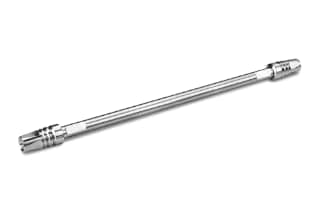
|
Chemistry |
C8 |
|
Separation Mode |
Reversed Phase |
|
Particle Substrate |
Silica |
|
pH Range Min |
2 pH |
|
pH Range Max |
8 pH |
|
Temperature Limits |
45 C |
|
Maximum Pressure |
18000 psi (1240 Bar) |
|
Endcapped |
Yes |
|
Silanol Activity |
Low |
|
Particle Shape |
Spherical |
|
Particle Size |
1.6 µm |
|
Endfitting Type |
Parker-style |
|
Pore Size |
90 Å |
|
Format |
Column |
|
Surface Area |
100 |
|
System |
UHPLC, UPLC |
|
Particle Technology |
Solid Core |
|
USP Classification |
L7 |
|
Inner Diameter |
2.1 mm |
|
Length |
150 mm |
|
Carbon Load |
4.5 % |
|
eCord |
Yes |
|
UNSPSC |
41115709 |
|
Brand |
CORTECS |
|
Product Type |
Columns |
|
Units per Package |
1 pk |
CORTECS Solid Core C8 Column, 90Å, 1.6 µm, 2.1 mm X 150 mm, 1/pk
For general technique development in low pH test circumstances, the CORTECS C8 Columns are employed. When combined with low-dispersive UPLC equipment, CORTECS 1.6 µm solid-core particle technology offers the highest column efficiency. In contrast to fully porous particles of comparable size, CORTECS 1.6 µm particles create sharper, narrower peaks, making CORTECS C8 Columns one of the best columns to choose for improved resolution, speed, and sensitivity.
Solid-core particles with a tri-functionally bound C8 Ligand are part of CORTECS UPLC C8 Columns. Compared to the C18 Ligand in the CORTECS UPLC Column Series, the C8 column is less hydrophobic since it contains a shorter alkyl chain. For the analysis of hydrophobic and very hydrophobic analytes, including fat-soluble vitamins, the CORTECS C8 Column's lower hydrophobicity results in shortened retention durations for numerous substances.
Vitamins like Vitamin E are classified as Fat Soluble Vitamins (FSVs), which are extremely hydrophobic substances. Reverse-phase liquid chromatography with C18 columns would require more time for analysis, increasing the cost of each experiment and analysis. However, C8 will be a far better choice because of its lower hydrophobicity, which cuts down on both analysis time and solvent expenses.
To ensure that you only receive the best goods from your lab, all of our lab equipment is produced under the strictest guidelines and subject to a rigorous quality assurance process. We suggest looking through our catalog or browsing our website if you're interested in comparing various Waters offerings or reviewing equipment that is compatible with the CORTECS C8 Column. From there, you can access in-depth information and details about all of Waters' products and easily shop for lab equipment in accordance with your laboratory's needs.
You might also be interested in the Cortecs C8 VanGuard Pre-column, 90Å, 1.6 µm, 2.1 mm X 5 mm, 3/pk; which has been created to increase the lifespan and performance of analytical columns by eliminating particle pollution from the mobile phase stream, may also be of interest to you. All CORTECS UPLC C8 analytical columns with 1.6 µm sorbent particles are protected by this pre-column, which is optimized for that purpose.
How Is Temperature Affecting Liquid Chromatography?
The analytes are either dissolved in the mobile phase of the chromatography or adsorbed to the stationary phase of the column in a sequence of equilibrium processes known as chromatography. If the temperature is higher, there is a quicker interchange of analytes between the mobile phase and the stationary phase. Thus, a faster analysis is achieved at higher temperatures.